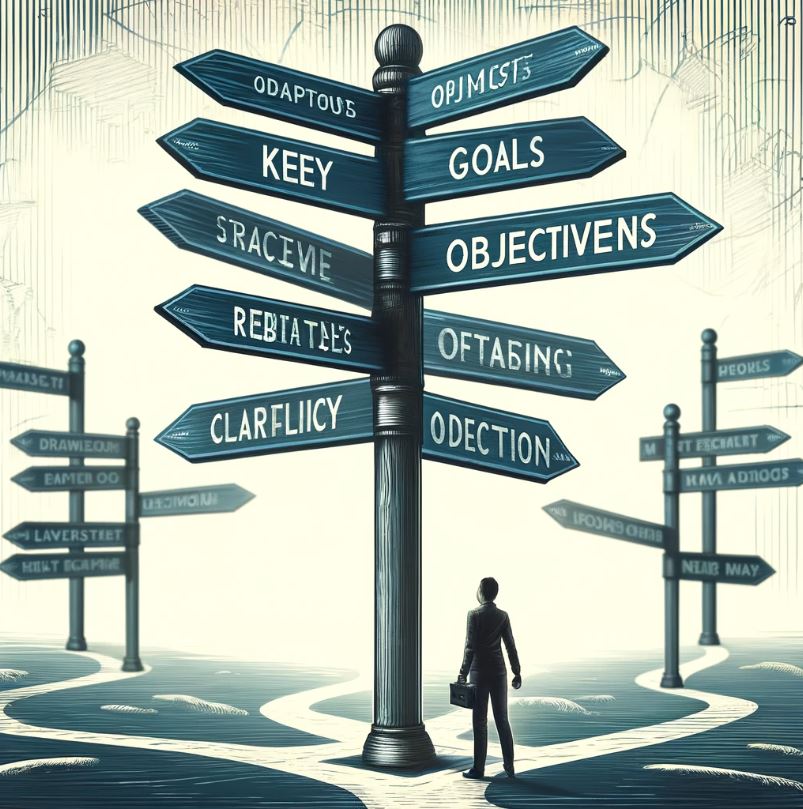Cultivating a Strategic Mindset: Insights and Inspirations from Go


In a world filled with challenges and opportunities, it is essential to develop a strategic mindset for both personal and professional success. Pam Didner, a seasoned marketing expert, outlines steps to foster this mindset, and the game of Go offers timeless wisdom on strategic thinking.
Understanding Strategic Thinking

Understanding strategic thinking involves recognizing it as a methodical process designed to achieve specific goals. It’s not simply about planning a course of action, but rather about deeply analyzing the current situation, exploring numerous alternatives, and making well-informed decisions that lead to desired outcomes. Here are some key aspects and facts to keep in mind:
- Goal-oriented Framework: Strategic thinking focuses on defining clear objectives and understanding the end goal before devising a strategy to get there.
- Questioning Approach: It involves asking critical questions like “What if?”, “Why?”, and “How can we?” to uncover opportunities and anticipate challenges.
- Options Exploration: Instead of jumping to the first solution, strategic thinkers weigh multiple pathways and scenarios, assessing their potential impacts and feasibility.
- Decision-making: Based on gathered insights and analysis, strategic thinkers make informed choices that align with long-term objectives.
- Adaptability: Recognizing that change is constant, strategic thinking includes planning for flexibility and being prepared to pivot strategies as needed.
To develop these skills, individuals and organizations can focus on enhancing their analytical abilities and fostering a forward-thinking mindset. They can also continuously evaluate their strategic processes against actual outcomes, which not only helps them achieve their goals but also enables them to navigate complex situations and uncertainties more effectively. This is the essence of strategic thinking.
Articulating Your Goals Clearly

In the realm of strategy, the ability to clearly articulate your goals is essential. It serves as a compass that guides every decision and action, no matter whether you’re planning for a house purchase or orchestrating a marketing campaign. This principle holds true whether you’re playing Go or any other game that requires strategic thinking. Drawing inspiration from the ancient game of Go, we can learn the importance of maintaining a holistic approach, seeing the big picture and ensuring that every step we take aligns with our overall goals. This approach helps us avoid getting lost in the details and ensures that we stay focused on what matters most.
- Vision and Clarity: Setting clear and specific goals is the first step in strategic thinking. Without a clearly defined destination, it can be difficult to create a viable plan for moving forward.
- Big Picture Thinking: Like Go players who must consider the entire board to strategize effectively, strategic thinkers need to understand how different elements of their plan fit into the larger picture.
- Alignment of Actions: Every action taken should directly contribute to the ultimate objectives, ensuring efficiency and purpose in every step.
- Flexibility and Adaptation: While maintaining focus on the end goal, it is essential to be flexible and adaptable to changing circumstances, without losing sight of the main objective.
Understanding that strategic thinking is not just about achieving an end goal, but also about taking informed and coherent steps towards it, is crucial. This approach ensures that resources are used efficiently, opportunities are seized, and challenges are overcome with foresight. By clearly defining your goals and aligning your actions with them, you create a path for successful strategic decision-making. This allows you to make informed choices that lead to positive outcomes.
The Game of Go: A Metaphor for Strategic Planning

Strategic thinking in the game of Go can serve as a powerful metaphor for strategic planning in life and business. This ancient board game, with its unparalleled depth and complexity, challenges players to outmaneuver their opponents by strategically placing stones on a grid. The goal is to capture as much territory as possible, requiring foresight, adaptability, and a deep understanding of the ever-changing landscape. These skills are essential for effective strategic planning in professional settings, where success often hinges on the ability to anticipate and adapt to shifting circumstances.
- Adaptability: Just as Go players adjust their strategies in response to their opponent’s moves, successful leaders must be flexible, able to pivot their approaches based on market changes and competitive dynamics.
- Long-term Planning: In Go, winning requires thinking several steps ahead, a skill that is directly applicable to strategic planning, where future scenarios need to be anticipated and prepared for.
- Complex Problem Solving: The game teaches players how to navigate complex situations, making it a great way to practice problem-solving skills that are essential for making strategic business decisions.
For those interested in enhancing their strategic thinking through the ancient game of Go, Gomagic has a wealth of resources available. Whether you are new to the game or want to deepen your knowledge, you can start by learning the basics with How to Play Go: Rules. To challenge yourself and improve your skills, visit Go Problems for puzzles of varying difficulty.And for a more immersive learning experience, explore the video courses with interactive elements available at Gomagic Courses. Engaging with Go through Gomagic not only sharpens your strategic thinking, but also provides a fun and rewarding way to develop skills that can be applied in various professional contexts.
Analyzing Options and Risks

To develop strategic thinking, focusing on analyzing options and risks is essential, similar to the strategic game of Go. In this game, every move requires anticipating future challenges and opportunities. This process involves diving deep into understanding not only the immediate outcomes of decisions, but also their long-term implications. This guide will help you enhance this skill.
- Identify Alternatives: Begin by mapping out all possible actions. This process is similar to the game of Go, where players consider every potential move and its impact on the board. The aim is to create a comprehensive list of options, including even those that may seem less viable at first.
- Evaluate Risks and Rewards: For each alternative, weigh the potential benefits against the risks. consider the potential benefits and risks. This evaluation should be both quantitative, using data and metrics whenever possible, and qualitative, taking into account factors such as market trends and the organizational impact.
- Scenario Planning: Engage in scenario planning to visualize how different choices might play out over time. This involves creating detailed stories for each option, taking into account variables such as market changes, competitor actions, and regulatory changes.
- Decision Trees: Use decision trees to organize the decision-making process. This tool allows you to visualize the possible outcomes of each option and the likelihood of each scenario.
- Risk Mitigation Strategies: Once risks have been identified, develop strategies to reduce them. This may include creating contingency plans, diversifying options, or forming strategic partnerships to share the burden of risk.
- Continuous Monitoring: After a decision has been made, it is important to continuously monitor its impact on the situation and the external environment. This allows for early detection of any unforeseen risks that may arise and enables timely adjustments to be made to the strategy.
Strategic thinking, much like playing Go, requires patience, foresight, and the ability to adapt to changing circumstances. By systematically analyzing options and risks, individuals and organizations can make more informed decisions that drive long-term success.
Decision Making and Implementation

In the realm of strategic thinking, the decision-making and implementation phase is crucial. the decision-making and execution phase is essential. This stage can be likened to making a well-thought-out move in the game of chess, where each choice is carefully considered in light of the current circumstances and potential consequences. Here, we explore how strategic thinking impacts decision-making and execution:
- Information Gathering: Just as in Go, where players must be acutely aware of the board’s state, strategic thinkers gather all relevant information and data before making a decision. This involves analyzing the internal and external environments, understanding competitive dynamics, and identifying trends and patterns.
- Option Evaluation: Strategic thinkers evaluate various courses of action, taking into account both short-term and long-term implications. They use tools such as SWOT analysis (Strengths, Weaknesses, Opportunities, Threats) to evaluate different strategies.
- Decision-Making: Choosing the best course of action requires careful consideration of the pros and cons of each option, as well as the availability of resources and alignment with overall strategic goals. Strategic thinkers weigh the potential risks and rewards of each decision, ensuring that they make choices that best serve the organization’s long-term success.
- Adaptability: Implementation is not about strictly following a plan, but rather adapting to changes and challenges as they occur. Strategic thinkers are able to modify their strategies based on new information and changing circumstances, ensuring resilience and flexibility.
- Execution: Effective execution requires clear communication of the strategy, delegation of tasks, setting measurable goals, and monitoring progress. Strategic thinkers ensure that there is alignment between strategy and action, focusing on efficiency and effectiveness.
- Learning and Feedback: After implementation, strategic thinkers analyze outcomes, gather feedback, and learn from successes and failures. This reflective process is essential for continuous improvement and future planning.
Strategic thinking in decision-making and implementation requires a systematic approach to dealing with complexities, predicting challenges, and capturing opportunities. It involves making informed decisions and adapting strategies to achieve desired goals in a constantly changing environment.
Continuous Learning and Adaptation

Strategic thinking is not a fixed skill, but a dynamic process that develops with experience and continued learning. Similar to how Go players carefully analyze their games in order to improve their strategies, individuals can also enhance their strategic thinking skills by reflecting on past decisions and outcomes. This process consists of several key stages:
- Review Past Decisions: Regularly review the results of past decisions, identifying both successes and failures. This reflection will help you understand the impact of your actions and decisions.
- Learn from Mistakes: Embrace failures as learning opportunities. Analyzing missteps can provide valuable insights into how strategies can be adjusted for better outcomes.
- Adapt Strategies: Based on reflection and learning, adapt your strategies to be more effective. This may involve changing tactics, focusing on different goals, or even rethinking your overall objectives.
- Continuous Learning: Stay informed about your field, emerging trends, and new strategies through formal education, self-study, and by seeking feedback from peers and mentors.
- Apply New Insights: Implement the lessons learned from both successes and failures, as well as new knowledge gained from continuous learning, into future strategic planning and decision-making.
This ongoing cycle of reviewing, learning, adapting, and applying is crucial for developing and improving strategic thinking skills. Through this process, individuals can become better at navigating complex challenges, predicting future trends, and achieving long-term goals.
Developing a strategic mindset is an ongoing process that requires self-reflection, planning, and flexibility. The ancient game of Go offers a valuable metaphor for understanding and implementing strategic principles in various aspects of life. By following the steps outlined by Pam Didner and applying the lessons learned from Go, anyone can become a more skilled strategic thinker, able to navigate the complexities of today’s world.





Оставить комментарий